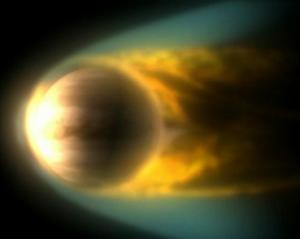
© ESA / C. CarreauInteraction between Venus and the solar wind.
Venus Express has made the first detection of an atmospheric loss process on Venus's day-side. Last year, the spacecraft revealed that most of the lost atmosphere escapes from the night-side. Together, these discoveries bring planetary scientists closer to understanding what happened to the water on Venus, which is suspected to have once been as abundant as on Earth.
The spacecraft's magnetometer instrument (MAG) detected the unmistakable signature of hydrogen gas being stripped from the day-side. "This is a process that was believed to be happening at Venus but this is the first time we measured it," says Magda Delva, Austrian Academy of Sciences, Graz, who leads the investigation.
Thanks to its carefully chosen orbit, Venus Express is strategically positioned to investigate this process; the spacecraft travels in a highly elliptical path sweeping over the poles of the planet.
Water is a key molecule on Earth because it makes life possible. With Earth and Venus approximately the same size, and having formed at the same time, astronomers believe that both planets likely began with similar amounts of the precious liquid. Today, however, the proportions on each planet are extremely different. Earth's atmosphere and oceans contain 100 000 times the total amount of water on Venus. In spite of the low concentration of water on Venus Delva and colleagues found that some 2x1024 hydrogen nuclei, a constituent atom of the water molecule, were being lost every second from Venus's day-side.